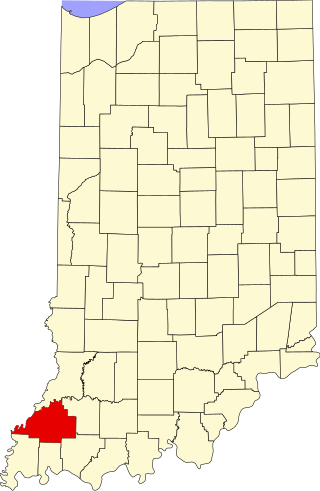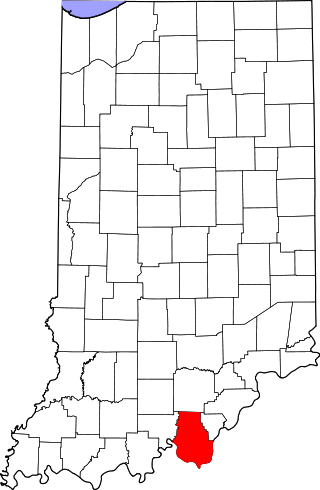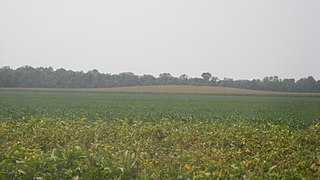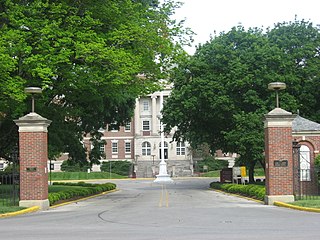
This is a list of properties and districts in Indiana that are listed on the National Register of Historic Places. There are over 1,900 in total. Of these, 39 are National Historic Landmarks. Each of Indiana's 92 counties has at least two listings.
The Hickory Ridge Cemetery Archeological Site (8ES1280) is an archaeological site in Pensacola, Escambia County Florida. It is located north of Big Lagoon and west of Pensacola. During excavations in the 1980s carbon dating was done on burnt wood fragments associated with burials in the mound, with a determination that the site had been used c. 1450. Analysis of ceramics suggested it was a Mississippian culture site, probably from the Late Bottle Creek Phase or Early Bear Point Phases of the Pensacola culture. It was a cemetery associated with a village nearby, (8ES1052). On September 22, 2000, it was added to the U.S. National Register of Historic Places.

The Indiana Register of Historic Sites and Structures was created in 1981 by the Indiana General Assembly. The Survey and Registration Section of the Indiana Division of Historic Preservation and Archaeology oversees this state register. All places within Indiana that are listed on the National Register of Historic Places are automatically on Indiana's Register. Additional sites are on the state register, as the state's register does not require as many documents and sources for inclusion.

Greencastle Township is one of thirteen townships in Putnam County, Indiana. As of the 2010 census, its population was 13,136 and it contained 4,810 housing units. This township contains the county seat of Greencastle and is home to DePauw University, a liberal arts college of 2,300 students.

Harrison Township is one of ten townships in Daviess County, Indiana. As of the 2010 census, its population was 696 and it contained 308 housing units.

Polk Township is one of eleven townships in Monroe County, Indiana. As of the 2010 census, its population was 360 and it contained 195 housing units. It is one of the least densely-populated townships in the state; this is largely because most of the land is occupied by Lake Monroe, the Hoosier National Forest, and seasonal homes and attractions.

Richland Township is one of eleven townships in Monroe County, Indiana, United States. As of the 2020 census, its population was 15,098 and it contained 6,455 housing units.

The congregation of Immanuel Lutheran Church in Valparaiso, Indiana, was founded in 1862 by 69 German families. The church building was erected in 1891 by Henry Lemster and his son, Charles. A fire gutted the building in 1975, marks of which can still be seen on the altar and pews. The Immanuel Lutheran congregation moved to a new site on Glendale Boulevard, while 60 members formed a new congregation named Heritage Lutheran Church and restored the historic building.

This is a list of the National Register of Historic Places listings in Tippecanoe County, Indiana.

This is a list of the National Register of Historic Places listings in Gibson County, Indiana.

This is a list of the National Register of Historic Places listings in Harrison County, Indiana.

The Mann site is a Crab Orchard culture site located off Indian Mound Road in Mount Vernon, Posey County, Indiana. It was placed on the National Historic Register on October 1, 1974. Exotic ceramics and other artifacts found at the site reflect contact with Ohio Hopewell people, in addition to more distant peoples in the Southeast of the Swift Creek culture of the Georgia Piedmont and Gulf Coastal Plain.

Dutch Ridge Historic District is a national historic district located in Perry Township, Allen County, Indiana. The district encompasses two contributing buildings and one contributing site in Perry Township. They are the Perry Township District School #1, or Dutch Ridge School (1888) with Queen Anne style design elements and the Late Gothic Revival style Salem Reformed Church (1876). Also located in the district is the Dutch Ridge Cemetery.

Glendale Park Historic District is a national historic district located at Hammond, Lake County, Indiana. The district encompasses 13 contributing buildings and 1 contributing site in an exclusively residential section of Hammond. It developed between about 1905 and 1926, and includes notable example of Colonial Revival, Tudor Revival, Prairie School and Bungalow / American Craftsman styles of residential architecture. The houses are arranged along a parkway with Glendale Park in the center.

Brendonwood Historic District, also known as Brendonwood Common, is a national historic district located at Indianapolis, Indiana. It encompasses 85 contributing buildings, 2 contributing sites, and 1 contributing object in a planned suburban residential section of Indianapolis. 350 acres on the eastern edge of Millersville with Fall Creek as the western boundary was the vision of Charles S. Lewis for a self-regulated residential zone of 110 plots. Noted landscape architect George E. Kessler was hired to develop the planned community. The district developed between about 1917 and 1954, and includes representative examples of Tudor Revival, Colonial Revival, and Bungalow / American Craftsman style architecture. Notable contributing resources include the Common House (1924), golf course, Two Knolls (1951-1952), Farlook (1939), Springhead (1934), Dearwald (1927), Wancroft (1940), Larkwing (1952), Grasmere (1937-1938), Wetermain (1921), Whispering Trees (1952-1953), Glen Gate (1922-1923), Witching View (1928-1929), Long Ridge (1923-1924) and Great Maple (1948).

Irvington Terrace Historic District is a national historic district located at Indianapolis, Indiana. It encompasses 578 contributing buildings and 9 contributing sites in a planned residential section of Indianapolis. The district developed between about 1895 and 1959, and includes representative examples of Tudor Revival, Colonial Revival, and Bungalow / American Craftsman style residential architecture.

Indianapolis Veterans Administration Hospital, also known as Larue D. Carter Memorial Hospital is a historic hospital complex and national historic district located at Indianapolis, Indiana. The district resources were developed between 1930 and 1951 by the Veterans Administration, and encompasses 15 contributing buildings, 2 contributing sites, 2 contributing structures and 5 contributing objects on the hospital campus. The main complex is connected by an enclosed corridor and consists of the main hospital building (1931), kitchen/mess hall/boiler house/attendants' quarters, general medical building (1939), and recreation building (1941). The buildings reflect the Colonial Revival and Classical Revival styles of architecture.

McCormick Cabin Site is a historic site located at Indianapolis, Indiana. It is the site of the cabin John Wesley McCormick (1754–1837) built in 1820. It was at the cabin that commissioners appointed by the Indiana legislature met in June 1820 to select the site for the permanent seat of state government at Indianapolis. The site is commemorated by a granite boulder in White River State Park with plaque erected in 1924.

Watson Park Historic District, also known as Watson Road Historic District and Watson McCord Neighborhood, is a national historic district located at Indianapolis, Indiana. The district encompasses 402 contributing buildings and 4 contributing sites in a predominantly residential section of Indianapolis. They include 255 houses, 27 multiple family dwellings, and 120 garages. It was developed between about 1910 and 1960, and includes representative examples of Colonial Revival, Tudor Revival, and Bungalow / American Craftsman style architecture. Located in the district is the Watson Park Bird Sanctuary.





















